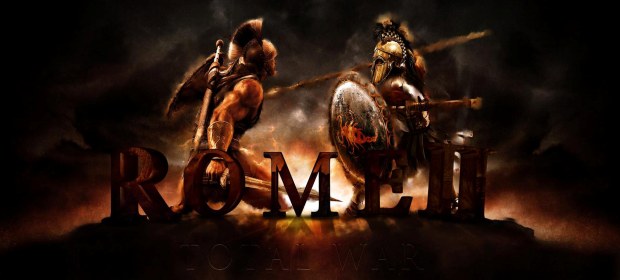I have to admit that my initial reaction to Total War: Rome II was a slightly negative one. But not for the reasons you may think. After a few hours with the game, as I began to grasp the scale and scope of this long-awaited RTS, I began to feel almost completely overwhelmed. There were so many factors to consider when making even what seem to be the simplest decisions that my mind was utterly boggled. But I persevered and, after many poor choices and crushing defeats, my apprehension gave way to appreciation and determination. Don’t get me wrong, I still felt overwhelmed, but it was the good kind now, like being caught in an avalanche of puppies or being smothered by marshmallows. I’m sure veterans of the series won’t have the same experience, but newcomers – even those with a penchant for the genre – may not even know where to start.
Thankfully, developers The Creative Assembly have included a prologue to introduce newbies to the Total War series, and reinitiate the old guard. This short mini-campaign is the only part of the game with a strong narrative element and focuses on the Roman Tribune Gaius Fulvius Silanus and his battles against the Samnites. Through a series of skirmishes, the player is introduced to the basics of the gameplay, and while it does provide a simple overview of the game, it barely scratches the surface in the grand scheme of things. It’s a good thing, then, that the Total War Encyclopaedia is on-hand to fill any blanks. This huge repository of knowledge, accessed easily in-game, contains everything from basic to advanced controls, full unit descriptions and instructions on every option and command. So if you’re one of the uninitiated, expect to spend the first few days switching in and out of this, learning what everything does.
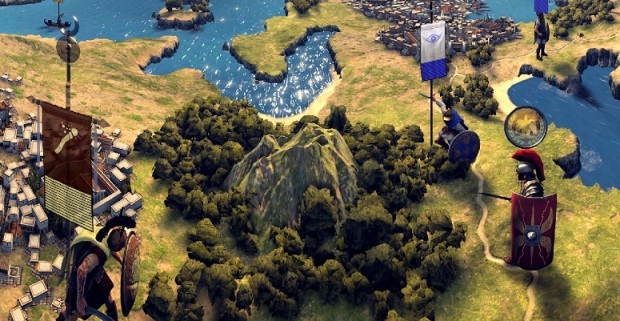
The campaign begins in 316 BC, with the quest to free captured Consuls Laenas and Rutilus, both of whom were defeated in battle by the Samnites. Now with the fledgling Rome state surrounded by Samnite forces, the player must first lay siege to the nearby settlement of Capua, break its defences and capture the town. After accomplishing this goal and finding Laenas slain, Silanus is elevated to the rank of Proconsul and must now defend the Campania region from a Samnite counter-attack, whilst capturing the nearby port of Salernum. With the port under Roman control, and trade and transport routes open, the player must make the final push towards the Samnite capital and free the imprisoned Rutilus.
This short introduction serves as a precursor to the grand campaign, which begins after the final battle and carries your current state forward. The narrative takes a backseat from here on, and the only ultimate goal is world domination. Total War: Rome II does offer objectives to you on the right path, such as allying with certain neighbouring states or controlling a specific region; and sub-objectives, such as constructing a sizable naval fleet or maintaining diplomatic relations. Completing these somewhat optional goals bring their own economic or tactical rewards, so it’s advisable to follow the game’s guiding hand as it does a pretty good job of ensuring you have the right resources in place.
Aside from these, you’re given free reign to conquer the known world as you see fit. And while you’re busy capturing settlements and vanquishing foes, other factions the world over are doing the same. The world continues to war with itself, so much so that you may never cross paths with some distant cultures as they are wiped out during the course of the grand campaign. While inside the bubble of your known surroundings, you sometimes forget the world at large is changing constantly, hidden behind the Fog of War across undiscovered lands. It’s a little unnerving, especially early on when you’re struggling to maintain control of your little region, knowing that there may be a colossal force massing on some uncharted shore, plotting invasion.

Only when you begin your quest to rule the world do you begin realise the true depth and detail of Total War: Rome II. Choosing which of the nine factions to start with greatly influences the gameplay experience. These nine, along with the 3 Greek states included in the Day 1 DLC, can be grouped into 4 cultural groups: Barbarian, Hellenic, Roman and Eastern. Each of these have very different play styles and pro & cons associated with them.
The biggest difference lies between the civilised factions like the Romans, and the barbarian hordes such as the Iceni. While Rome & Carthage rely on provincial Capitals to generate superior revenue and recruitment, the barbarians spread these tasks across many settlements, allowing armies to be raised in more locations, but have less efficient industry and sources of income. Furthermore, the 4 cultural groups each have a speciality: the Romans are superior at growth; the Hellenics are better researchers and food producers; the Eastern factions are great traders; and the Barbarians have higher morale in battle. The nine factions differ even further, each with its own tech trees, famous generals, agent variants, units, traits and benefits. While it may seem daunting even picking your faction, know that the game is not radically different with whomever you decide to side with as each has their own strengths and weaknesses.
Gameplay alternates between macro and micro management, which is very handy when it comes to governing your ever-expanding empire. As Real Time Strategy game , it handles like previous Total War titles, but there are some notable improvements. Before the battle begins, you have the opportunity to arrange units across the frontline in the most tactically advantageous way, setting up the main battle force, placing forward scouting units or positioning smaller forces on the fringes for flanking manoeuvres. Line of sight plays a big role in this iteration of the series, with terrain blocking your vision and allowing enemy forces to use hills, trees and walls as cover. Scouting parties therefore become very important in assessing the full strength of the opposing force.
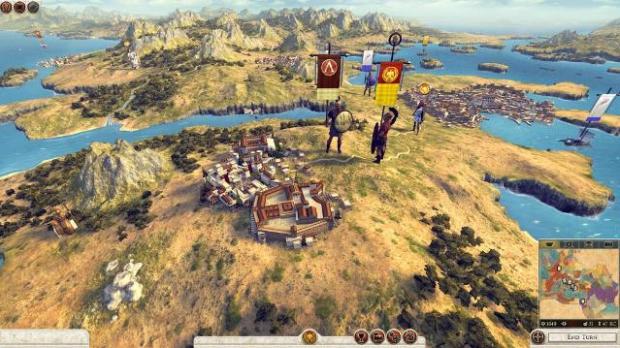
The huge roster of units (over 700 across both playable and non-playable factions) are grouped according to type and can be arranged in a variety of formations both individually and as part of the larger army. The game offers preset formations, each suited to an attacking or defensive situation such as taking a besieged town or holding ground on the open battlefield. Units also have behaviour presets outside of just directly attacking enemies. For example, ranged units can be ordered to hold their ground or enter skirmish mode, where they will retreat to a safe firing position when approached by melee units. It’s a great tactical feature but it’s important to manage which units use this option because there’s nothing worse than seeing your entire right flank of archers fall apart as they flee from incoming swordsmen.
The camera has undergone some changes, with the addition of the RTS camera, a dynamic battlefield PoV controlled by the mouse and WASD keys. A tactical view has also been added that provides an overview of the entire area, showing troop locations, terrain and line of sight. By far the most exciting (albeit the least useful) viewpoint is offered by the unit camera, which akes you into the first person view of any selected unit and is truly amazing when charging into battle. Sometimes in RTS games, excitement is in short supply as you hover ethereally above the battlefield and soldiers are reduced to mere dots on a map. This camera you right into the action with visceral force, as a thousand voices roar above the thunder of boot and hoof, in the midst of a triumphant charge towards death or glory.
Aside from the straight open warfare, the naval system has been improved for this entry to the series. Sea and land battles are now combined into the singular battle system, allowing both to contain elements from each, adding a further layer to skirmishes. Ships are either one of 2 core types: Mediterranean ships that are fast, light and useful for fielding siege weapons or barbarian boats, heavy and strong but less effective when ramming. This naval overhaul is an excellent addition and opens up lots of tactical avenues when assaulting coastal regions. It also makes any battle near the open sea or on large rivers much more dynamic, with reinforcements able to land in a moment’s notice on a nearby beach to bolster the land assault. Controlling sea routes and strategic ports offer economic benefits too, opening trade corridors with distant lands.
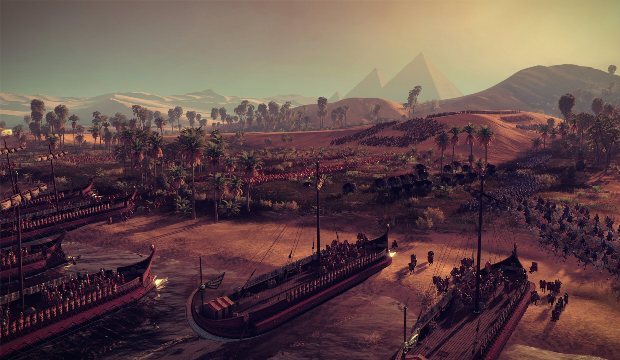
Outside of battles, on the macro level, things become much more political and arguably more strategic. Here, actions such as troop movements, recruiting, construction and research are all governed by a number of turns. It’s a lot less exciting than battles but no less engrossing, and managing everything that lies within your ever-expanding borders is not an easy task. Conquered regions are now grouped into provinces, which must be closely maintained on a number of levels. Settlements can be expanded and improved with more buildings, public order must be kept in check by balancing low taxes while generating enough revenue to maintain your army. Towns can be garrisoned with an occupying force to defend against attack and quell any uprisings, and capturing new towns offers you the option of enslaving the population, killing the captives or merely occupying the settlement. Your choice may damage your reputation with your allies or show weakness to your enemies, so it’s important to weigh up the consequences. This kind of choice is indicative of Rome II as a whole, as no decision is without repercussion.
Agents can also be recruited to assist your armies in other ways, but only on the world map. These stand alone units have a variety of specific skills that aid your conquests, and are extremely valuable assets. The spy is useful for disruption and assassinations, such a poisoning a town’s water supply, the Champion rallies troops or incites slave uprisings while the Dignitary can negotiate economic sanctions or dissuade revolt in friendly regions.
But it’s not all about war, surprisingly, and there are plenty of other ways to conquer without the sword and shield. Diplomacy and politics play a large part in the game. Negotiations with neighbouring states can be as simple as signing trade agreements or non-aggression pacts all the way to full military alliances. It’s vital to maintain strong diplomatic ties with a few factions, just in case you incur the wrath of a superior force, at which point you’ll need friendlies to come to your aid.
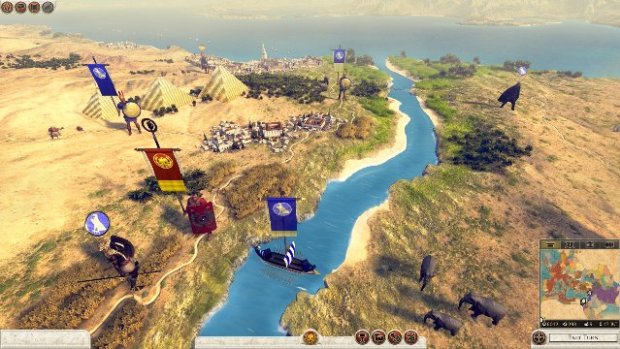
Total War: Rome II almost seems like two different games when alternating between the RTS battles and the turn-based province manager. In fact, as my campaign went on, I found myself fighting less and less battles. When you challenge an opposing force, or are on the business end of an invasion, the game presents you with the option of auto-resolving the conflict. On this screen, the likelihood of victory or defeat is presented in statistical form complete with potential troop losses, depending on your proposed battle strategy. I found it was much easier just to trust these numbers and let the game decide, unless of course I was facing certain defeat. Then it was time to dive in, and duke it out in a vain attempt to prove the computer wrong. This isn’t necessarily a bad thing, and you always have the option of commanding the battle yourself, but with so much to do on the macro level, choosing to manually fight a battle becomes a little irrelevant.
Rome II is stunning to look at, even on lower graphical settings. It may not be that noticeable from the eye-in-the-sky default view, but zooming in close to the action reveals the pains that The Creative Assembly have gone to. Roman armour glistens in the sun, barbarian tattoos peek through the mud staining their skin and mighty ships crash through crested cyan waves. Unit animations are beautifully realistic, and it’s easy to forget you have a job to do when you’re watching your armies from the ground level as they slaughter hundreds of enemy soldiers. The musical score and sound effects are also worth mentioning, setting the mood perfectly both in and out of battle.
Historical encounters provide a worthy diversion to the main campaign, allowing you to undertake notable military actions from the era. It also allows you to try out new units as-yet unlocked in campaign mode and fight on battlefields and environments not yet reached. Multiplayer mode is present in two flavours: head to head with up to 4 other players or Co-op mode. A quick match option has also been introduced which enables players to choose a faction and jump straight into a matchmade game with a balanced, preconfigured force. I did not get a chance to test the multiplayer in action but it seems to be very well-designed and fully featured.
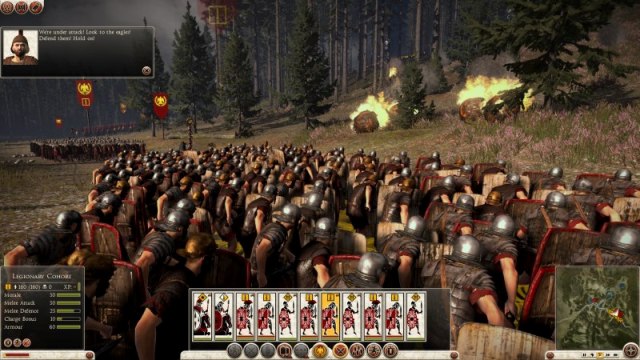
VERDICT: Total War: Rome II is an absolutely fantastic game, pure and simple. The Creative Assembly had a lot to prove with this direct sequel to the critically acclaimed first instalment and they not only rose to the challenge, but surpassed it in many ways. It’s by no means easy, and takes a hefty investment of time to fully appreciate. Even after the tutorial prologue, you’ll have a lot to learn, but it’s a testament to the developers that they were able to create an engrossing game that draws you in even with such a steep learning curve. With the unique aspects of each factions, extra game modes, a robust multiplayer and plenty of planned DLC, there are hundreds of hours of quality gameplay awaiting you in ancient Rome.

SUPERB. This is the mark of greatness, only awarded to games that engage us from start to finish. Titles that score 9/10 will have very few problems or negative issues, and will deliver high quality and value for money across all aspects of their design.


